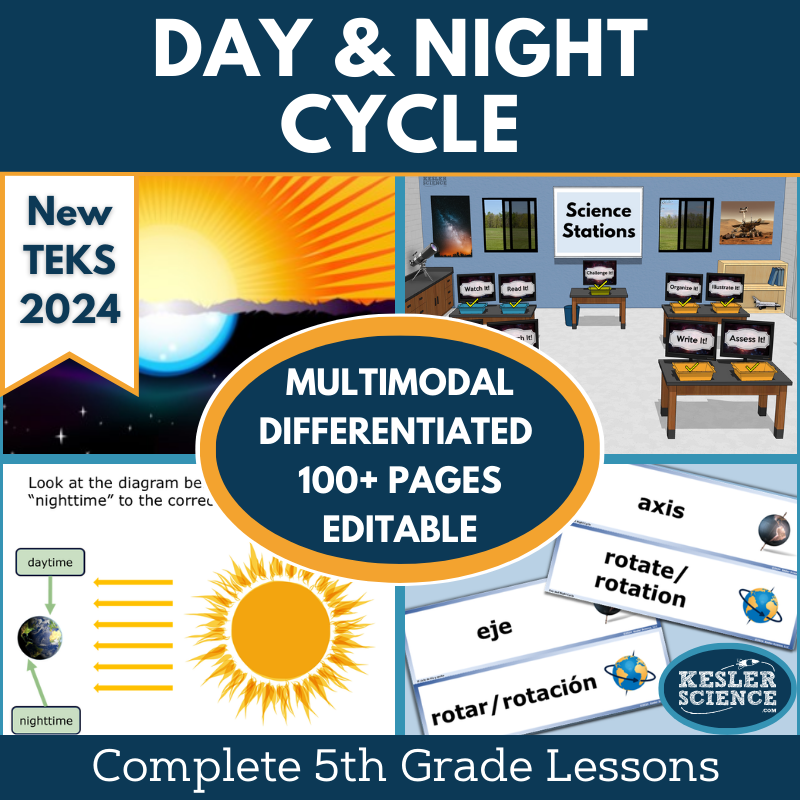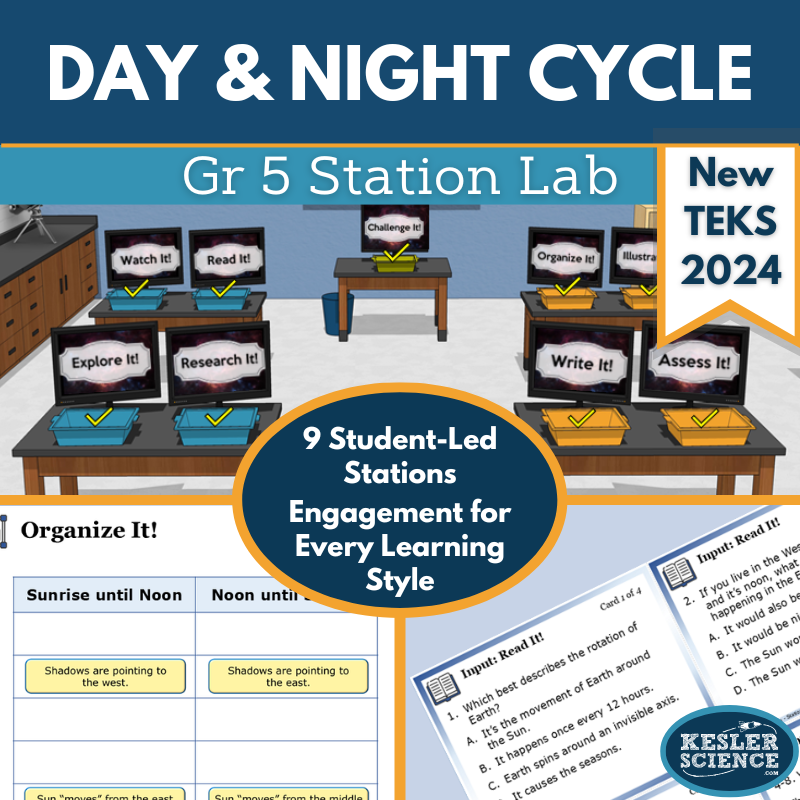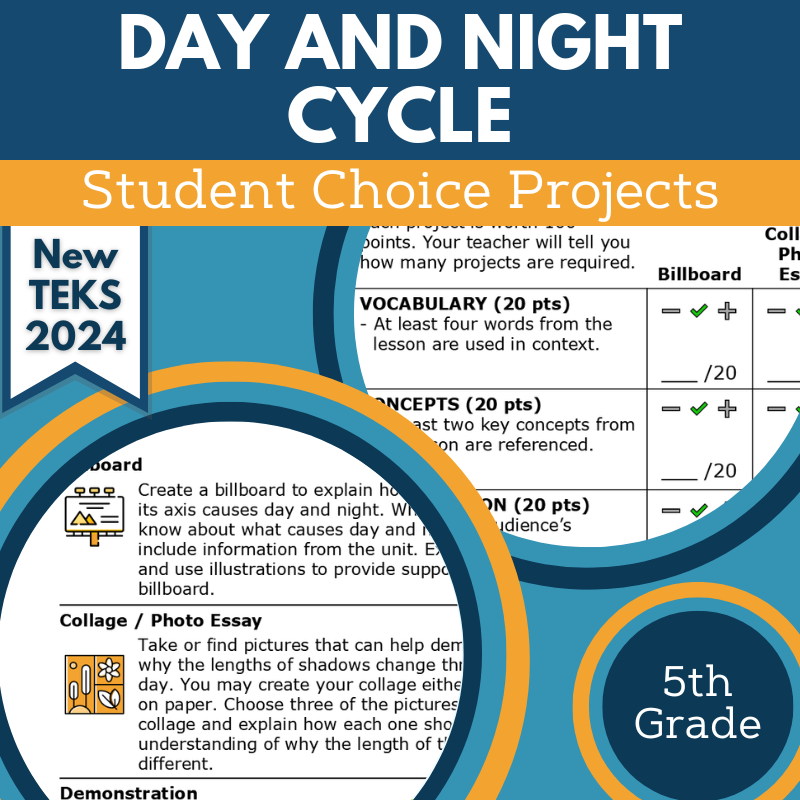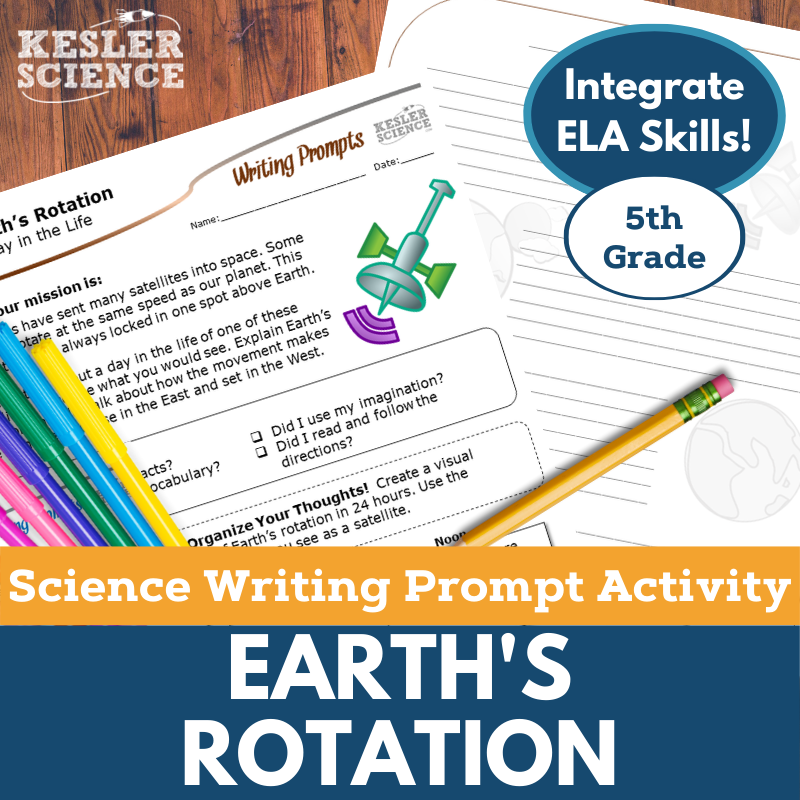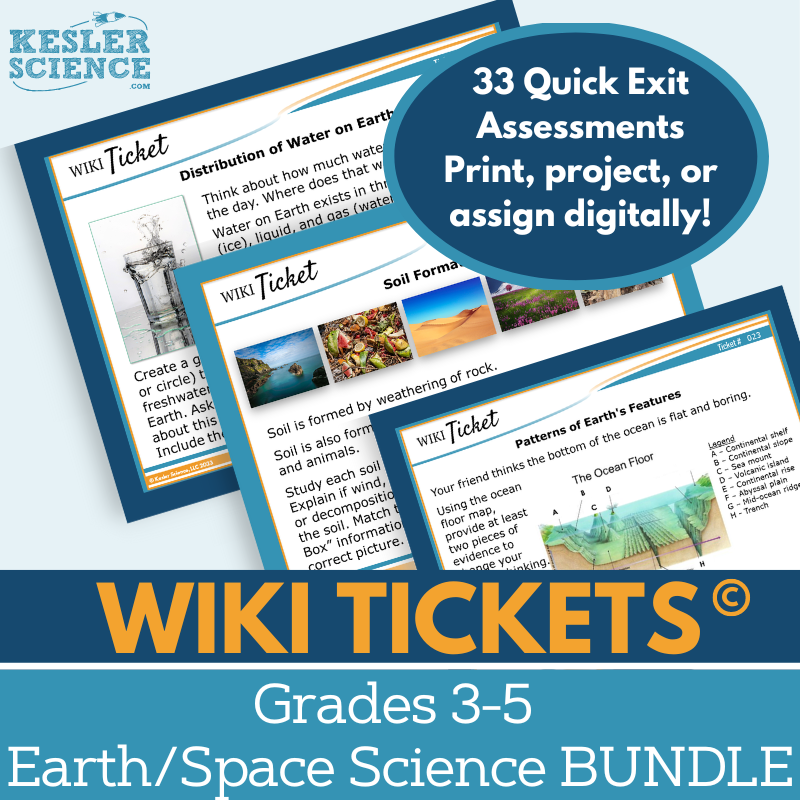Day & Night Cycle Activities for 5th Grade Science
This Earth and space science unit helps elementary students understand Earth’s rotation and how it causes the day/night cycle, the movement of the Sun, and shadow changes. The resources below will give students a comprehensive understanding of Earth's day and night cycle. All of the following materials are also included in the Kesler Science Membership.
This elementary Earth and space science unit helps students understand Earth’s rotation on its axis and how it causes the day/night cycle and the movement of the Sun across the sky, resulting in changes in shadows. It includes presentations, worksheets, choice projects, and assessments, all of which are editable and require little preparation. The lesson promotes differentiated, student-led learning, providing more support where needed.
The lesson follows the 5E Model and covers engagement, exploration, explanation, elaboration, and evaluation stages. Students will explore topics like how Earth rotates every 24 hours and how this impacts shadows and daylight patterns through hands-on, differentiated station labs. Activities include reading comprehension, videos, research tasks, and open-ended questions. PowerPoints, interactive notebooks, and assessment questions are available in both English and Spanish.
Projects allow students to apply their learning, and assessment materials are updated for STAAR 2.0. The lesson is adaptable for in-class or virtual environments, offering maximum flexibility for diverse learning needs and styles. The lesson is aligned with TEKS 5.9 and includes resources for effective classroom management.
This elementary Earth and space science unit helps students understand Earth’s rotation on its axis and how it causes the day/night cycle and the movement of the Sun across the sky, resulting in changes in shadows. It includes presentations, worksheets, choice projects, and assessments, all of which are editable and require little preparation. The lesson promotes differentiated, student-led learning, providing more support where needed.
The lesson follows the 5E Model and covers engagement, exploration, explanation, elaboration, and evaluation stages. Students will explore topics like how Earth rotates every 24 hours and how this impacts shadows and daylight patterns through hands-on, differentiated station labs. Activities include reading comprehension, videos, research tasks, and open-ended questions. PowerPoints, interactive notebooks, and assessment questions are available in both English and Spanish.
Projects allow students to apply their learning, and assessment materials are updated for STAAR 2.0. The lesson is adaptable for in-class or virtual environments, offering maximum flexibility for diverse learning needs and styles. The lesson is aligned with TEKS 5.9 and includes resources for effective classroom management.
This student-led station lab aligns with TEKS 5.9 and focuses on Earth’s rotation, the day/night cycle, and changes in shadow patterns. Designed for 5th-grade students, the lab encourages independent learning with nine modular, differentiated stations. The activities help students understand how Earth rotates on its axis every 24 hours, explaining the causes of the day/night cycle and the movement of the Sun across the sky. Students will explore how shadows change throughout the day, connecting new concepts through a variety of tasks.
Each station offers different ways to engage with the material. Activities include watching a video about shadow changes, reading passages with comprehension questions, and manipulating images in digital formats. Students will also research the relationship between light intensity and shadow length, perform hands-on tasks, and illustrate their learning by drawing models of shadow changes. Additionally, they will communicate their understanding through written responses and assessments, reinforcing key concepts in a structured and interactive way.
The station lab promotes student-centered learning, allowing students to complete activities independently or in small groups. It’s designed to be flexible for both in-person and virtual learning environments. With minimal prep required, this resource saves teachers time while fostering active, hands-on learning that enhances understanding of Earth science concepts related to the day/night cycle and shadow patterns.
This student-led station lab aligns with TEKS 5.9 and focuses on Earth’s rotation, the day/night cycle, and changes in shadow patterns. Designed for 5th-grade students, the lab encourages independent learning with nine modular, differentiated stations. The activities help students understand how Earth rotates on its axis every 24 hours, explaining the causes of the day/night cycle and the movement of the Sun across the sky. Students will explore how shadows change throughout the day, connecting new concepts through a variety of tasks.
Each station offers different ways to engage with the material. Activities include watching a video about shadow changes, reading passages with comprehension questions, and manipulating images in digital formats. Students will also research the relationship between light intensity and shadow length, perform hands-on tasks, and illustrate their learning by drawing models of shadow changes. Additionally, they will communicate their understanding through written responses and assessments, reinforcing key concepts in a structured and interactive way.
The station lab promotes student-centered learning, allowing students to complete activities independently or in small groups. It’s designed to be flexible for both in-person and virtual learning environments. With minimal prep required, this resource saves teachers time while fostering active, hands-on learning that enhances understanding of Earth science concepts related to the day/night cycle and shadow patterns.
The Day and Night Cycle Student Choice Projects align with the 2021 TEKS Earth and Space Science standard 5.9, offering 5th graders the option to select a project that suits their preferred output style. The project page includes six student-led project options, plus a “design your own” choice, and an editable rubric for assessment by teachers, peers, or the students themselves.
These projects are flexible and dynamic, with teachers able to adjust the rubric to fit grading needs. The multimodal options allow students to demonstrate their understanding in creative and personalized ways.
The resource includes a choice board with nine project options, a teacher directions page, and an editable rubric that evaluates vocabulary, concepts, presentation, clarity, and accuracy. It also provides differentiated options for students needing remediation and challenge. Most projects require basic classroom supplies like paper, markers, and scissors, and many can be completed digitally.
The Day and Night Cycle Student Choice Projects align with the 2021 TEKS Earth and Space Science standard 5.9, offering 5th graders the option to select a project that suits their preferred output style. The project page includes six student-led project options, plus a “design your own” choice, and an editable rubric for assessment by teachers, peers, or the students themselves.
These projects are flexible and dynamic, with teachers able to adjust the rubric to fit grading needs. The multimodal options allow students to demonstrate their understanding in creative and personalized ways.
The resource includes a choice board with nine project options, a teacher directions page, and an editable rubric that evaluates vocabulary, concepts, presentation, clarity, and accuracy. It also provides differentiated options for students needing remediation and challenge. Most projects require basic classroom supplies like paper, markers, and scissors, and many can be completed digitally.
The Earth’s Rotation Science and ELA Integrated Writing Activity engages 5th grade students in testing their knowledge about Earth’s axis through a fun, day-in-the-life format. TEKS aligned, the activity enhances students' understanding of Earth’s rotation and the day/night cycle, making it ideal for both in-person and virtual learning environments.
This resource includes teacher directions with an answer guide and rubrics, projection versions for class sharing, full-sized and half-sheet handouts, and a digital interactive PowerPoint version that works with Google Slides. It can be used for cross-curricular activities, pre-tests, student choice projects, or differentiation. The prompts are designed to support students' writing and exploration of science topics and can also be used for extra credit, make-up work, or TELPAS samples.
These activities are perfect for enhancing student engagement and can be displayed on bulletin boards or compiled into an anthology for each student. The prompts assume prior knowledge of the topic or access to research materials.
The Earth’s Rotation Science and ELA Integrated Writing Activity engages 5th grade students in testing their knowledge about Earth’s axis through a fun, day-in-the-life format. TEKS aligned, the activity enhances students' understanding of Earth’s rotation and the day/night cycle, making it ideal for both in-person and virtual learning environments.
This resource includes teacher directions with an answer guide and rubrics, projection versions for class sharing, full-sized and half-sheet handouts, and a digital interactive PowerPoint version that works with Google Slides. It can be used for cross-curricular activities, pre-tests, student choice projects, or differentiation. The prompts are designed to support students' writing and exploration of science topics and can also be used for extra credit, make-up work, or TELPAS samples.
These activities are perfect for enhancing student engagement and can be displayed on bulletin boards or compiled into an anthology for each student. The prompts assume prior knowledge of the topic or access to research materials.
WIKI Tickets formative assessments for 3rd-5th grade science provide a fun and engaging way to check student understanding. The Earth/Space Science Set includes 33 assessments, each with five formats: a full-screen projection version, three handout versions (full, split, and quarter-page sizes), and an interactive version for digital assignment through PowerPoint or Google Slides.
Aligned with NGSS and TEKS standards, these assessments cover key topics such as weather patterns, Earth’s surface changes, the water cycle, renewable and nonrenewable resources, and more. Some topics include multiple tickets, with a bonus table of contents file to show alignment.
These assessments can be used in both in-person and virtual learning environments, with options for projection, printouts, or digital use. They can serve as exit tickets, bellringers, or quick checks for understanding.
WIKI Tickets formative assessments for 3rd-5th grade science provide a fun and engaging way to check student understanding. The Earth/Space Science Set includes 33 assessments, each with five formats: a full-screen projection version, three handout versions (full, split, and quarter-page sizes), and an interactive version for digital assignment through PowerPoint or Google Slides.
Aligned with NGSS and TEKS standards, these assessments cover key topics such as weather patterns, Earth’s surface changes, the water cycle, renewable and nonrenewable resources, and more. Some topics include multiple tickets, with a bonus table of contents file to show alignment.
These assessments can be used in both in-person and virtual learning environments, with options for projection, printouts, or digital use. They can serve as exit tickets, bellringers, or quick checks for understanding.
Year-Round Resources
These year-round activities will increase your students' understanding of many middle school science topics. All of these activities are also included in the Kesler Science Membership.
Visual Data & Graphing
You're not alone if your students struggle with understanding graphs, charts, and tables. It's a skill that takes an enormous amount of practice. This resource will help students build a strong foundation in analyzing data and creating their own data visualizations.
Bell Ringers and Warm-Ups
These middle school science bell ringers are an excellent way to engage your students as soon as they walk into your classroom. This comprehensive FULL YEAR resource includes everything you need to start off each science class with an interesting warm-up activity.
Review Board Games
Each game board has been carefully designed to keep students engaged. There are 10 different action spaces on each board and dozens of question cards. All of the actions are related to science concepts and keep the students motivated throughout the game.
Each game is ready to play. Simply print out the board and the cards and let the students enjoy reviewing nine different units.
Essential Questions and Standards
Below are the essential questions and standards associated with the lessons and activities included in the atoms unit. This topic is only one of more than 100 middle school science topics included in the Kesler Science Membership.
-
Describe how Earth rotates on its axis once, approximately every 24 hours.
-
Explain how Earth’s rotation causes the day/night cycle.
-
Explain how the appearance of the Sun moving across the sky results in changes in shadow positions and shapes.
-
TEKS Science - 5.9 Day & Night Cycle
Kesler Science Membership
Imagine never having to search for another middle school science lesson again. The membership gives you access to ALL of the Kesler Science products in one place (Yes, including everything above).
Say goodbye to long hours of lesson prep.

